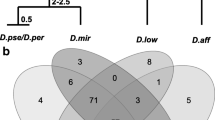Abstract
In most reports in which the activity of numerous Drosophila transposon families has been studied, only a subset of the families tested appears mobile. A comparison of these data shows that there are no transposons inherently more unstable than others and suggests that host factors regulate the activity of transposable elements. Consistent with this conclusion are the properties of Bari 1 elements, which are the only ones of the 14 families tested to be unstable in Charolles stock. Instability is persistent over 53 generations and appears to affect recurrent insertion sites.
Similar content being viewed by others
References
Biémont, C., A. Aouar & C. Arnault, 1987. Genome reshuffling of the copia element in an inbred line of Drosophila melanogaster. Nature 329: 742–744.
Caizzi, R., C. Caggese & S. Pimpinelli, 1992. Bari 1, a new transposon-like family in Drosophila melanogaster with unique heterochromatic organization. Genetics 133: 335–345.
Caggese, C., S. Pimpinelli, P. Barsanti & R. Caizzi, 1995. The distribution of the transposable element Bari 1 in the Drosophila melanogaster and Drosophila simulans genome. Genetica 96: 269–283.
Charlesworth, B., P. Sniegowski & W. Stephan, 1994. The evolutionary dynamics of repetitive DNA in eukaryotes. Nature 371: 215–220.
Clark, D.J., V.W. Bilanchone, L.J. Haywood, S.L. Dildine & S.B. Sandmayer, 1988. A Yeast sigma composite element, Ty3, has properties of a retrotransposon. J. Biol. Chem. 263: 1413–1423.
Chalker, D.L. & S.B. Sandmayer, 1990. Transfer RNA genes are genomic targets for de novo transposition of the yeast retrotransposon Ty3. Genetics 126: 837–850.
Di Franco, C., D. Galuppi & N. Junakovic, 1992. Genomic distribution of transposable elements among individuals of an inbred Drosophila line. Genetica 86: 1–11.
Di Franco, C., A. Terrinoni, D. Galuppi & N. Junakovic, 1995. DNA extraction from Drosophila individual flies. DIS 76: 172–174.
Di Franco, C., A. Terrinoni, P. Dimitri & N. Junakovic, 1997. Intragenomic distribution and stability of transposable elements in euchromatin and heterochromatin of Drosophila melanogaster: elements with inverted repeats Bari 1, hobo and pogo. J. Mol. Evol. 45: 247–252.
Dominguez, A. & J. Albornoz, 1996. Rates of movement of trans-posable elements in Drosophila melanogaster. Mol. Gen. Genet. 251: 130–138.
Eggleston, W.B., D.M. Johnson-Shlitz & W.R. Engels, 1988. P-M hybrid dysgenesis does not mobilize other transposable element families in Drosophila melanogaster. Nature 331: 368–370.
Fisher, R.A., 1958. The general theory of natural selection. Dover Publications Inc., New York, pp. 80–90.
Harada, K., K. Yukuhiro & T. Mukai, 1990. Transposition rates of movable genetic elements in Drosophila melanogaster. Proc. Natl. Acad. Sci. 87: 3248–3552.
Jack, J.W., 1985. Molecular organization of the cut locus of Drosophila melanogaster. Cell 42: 869–876.
Ji, H., D.P. Moore, M.A. Blomberg, D.F. Braiterman, D.F. Voytas, G. Natsoulis & J.D. Boeke, 1993. Hotspots for unselected Ty1 transposition events on yeast chromosome III are near tRNA genes and LTR sequences. Cell 73: 1007–1018.
Kim, A.I., E.S. Belyaeva & M.M. Aslanyan, 1990. Autonomous transposition of gypsy mobile elements and genetic instability in Drosophila melanogaster. Mol. Gen. Genet. 224: 303–308.
Kim, A.I., N.V. Lyubomirskaya, E.S. Belyaeva, N.G. Shostack & Y.V. Ilyin, 1994. The introduction of a transpositionally active copy of retrotransposon gypsy into the Stable Strain of Drosophila melanogaster causes genetic instability. Mol. Gen. Genet. 242: 472–477.
Mevel-Ninio, M., M.C. Mariol & M. Gans, 1989. Mobilization of the gypsy and copia retrotransposons in Drosophila melanogaster induces reversion of the ovo D dominant sterile mutations: molecular analysis of the revertant allelles. EMBO J. 8: 1549–1558.
Nuzhdin, S.V. & T.F.C. Mackay, 1994. Direct determination of retrotransposon transposition rates in Drosophila melanogaster. Genet. Res. Camb. 63: 139–144.
Pasyukova, E.G. & S.V. Nuzhdin, 1993. Doc and copia instability in an isogenic Drosophila melanogaster stock. Mol. Gen. Genet. 240: 302–306.
Prud'homme, N., M. Gans, M. Masson, C. Terzian & A. Bucheton, 1995. Flamenco, a gene controlling the gypsy retrovirus of Drosophila melanogaster. Genetics 139: 697–711.
Terrinoni, A., C. Di Franco, P. Dimitri & N. Junakovic, 1997. Intragenomic distribution and stability of transposable elements in euchromatin and heterochromatin of Drosophila melanogaster: non-LTR retrotransposons. J. Mol. Evol. 45: 145–153.
Voytas, D.F. & J.D. Boeke, 1993. Yeast retrotransposons and tRNAs. Trends Genet. 91: 421–427.
Wilke, C.M., E. Maimer & J. Adams, 1992. The population biology and evolutionary significance of Ty elements in Saccharomyces cerivisiae. Genetica 86: 155–173.
Author information
Authors and Affiliations
Rights and permissions
About this article
Cite this article
Junakovic, N., Di Franco, C. & Terrinoni, A. Evidence for a host role in regulating the activity of transposable elements in Drosophila melanogaster: the case of the persistent instability of Bari 1 elements in Charolles stock. Genetica 100, 149–154 (1997). https://doi.org/10.1023/A:1018325427405
Issue Date:
DOI: https://doi.org/10.1023/A:1018325427405




